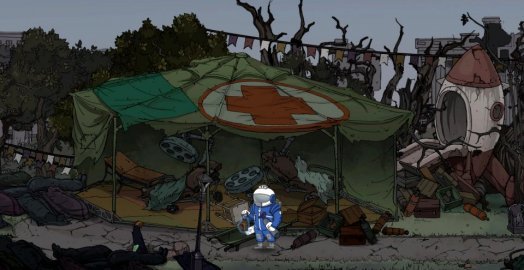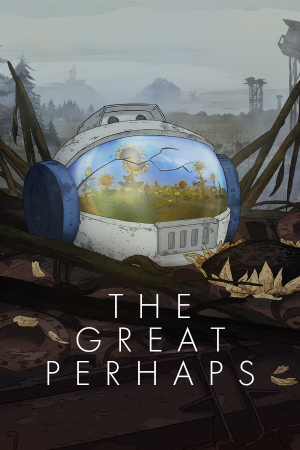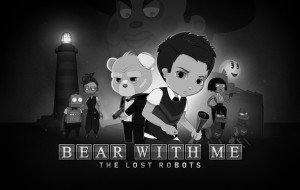Review for The Great Perhaps

“This is not the moon. Not some unknown planet. This is my home. The Earth. I don’t know what happened. What do I do now?”
These are the words of Kosmos, an astronaut who is startled by a sudden explosion on the planet below while performing routine maintenance on a space station in Caligari Games’ The Great Perhaps. Making his way back inside, Kosmos puts himself into cryogenic sleep and awakens 100 years later only to discover that there are no signs of life, no communication signals, no satellites, nothing coming from Earth. He is alone. His initial reaction upon realizing that even if his family survived the catastrophe they would be long dead anyway is to attempt to kill himself. A game protagonist wanting to die is quite a jarring concept, in a good way, and probably realistic under the circumstances. Yet the whole idea is waved quickly away when L9, the station’s sentient computer, refuses to remove the oxygen and instead urges Kosmos to return home, taking the A.I. along for the journey.
Following L9’s advice, Kosmos finds a lantern once he touches down on Earth. He doesn’t understand why, but he quickly discovers that by switching it on he is somehow transported into the past before the cataclysm that nearly wiped out the Earth. Kosmos wants to visit his old house to see if he can find out what happened to his family, but the lantern provokes another idea within him: that he might be able to change the timeline by effecting events in the past. L9 is some assistance to Kosmos as she can locate any human survivor on the planet (there’s only one life sign in a thousand-mile radius of their landing site) and give him suggestions of what to do and guide him where to go.
Unfortunately, the temptation to commit suicide and the time-altering lantern are interesting ideas whose deeper complexities are never really explored, a problem that occurs time and again during the two or three hours it takes to play this debut release by the independent Russian studio. As a result, both the story and gameplay end up feeling far more superficial than they should, which is a shame in such a beautifully hand-painted side-scroller with the promise of so much more.
The lantern in particular is really a great conceit with a lot of potential, but its use is dumbed down to mostly just being a simple way to get past obstacles. The subway system has collapsed in the present, so simply flick on the lantern and walk through in the past, albeit evading active subways and subterranean beasts along the way. More often than not, alternating between eras is going to be the solution to the puzzles you encounter. If there’s something in your path, the best first option is always to change to the other time period and see if it is simply unblocked there. You can transport yourself back to the present at any time, but spend too long in the past and you will be automatically returned to the present after an undetermined amount of time, which is needlessly frustrating.
What’s worse, sometimes when you travel forwards or backwards in time, you can arrive in a situation where you instantly die. Changing between the past and present requires you to hold down the appropriate key or gamepad button for a couple of seconds, while simply tapping it will show just a small portion of the other time period within the lantern’s direct line of sight. This is useful to check if there is something that could kill you in the other zone, although success in cheating death from unanticipated hazards is not always guaranteed. Dying will automatically return you to an earlier autosave checkpoint, which are not usually too far back so there’s not a lot of replaying large portions of the game.
Many puzzles require you to fetch items to progress, again usually from the opposite reality than the one you’re currently in. Some are simple, like finding a key for a door, while giving a little girl a present in exchange for the gate keys she is holding is more complicated. Certain challenges presented in a close-up view are more traditional puzzles. For example, at one point Kosmos must reassemble a conduit by turning the pieces until they fit together so that the electricity can flow. There’s also the matter of moving environmental objects around to accomplish tasks, such as pushing an old wagon into mud so you can cross. These sorts of things are easily accomplished but do add another layer of variety to the gameplay. Most of the puzzles are simple enough and presented in a logical fashion, so players shouldn’t have much difficulty in solving them without much thought.
Another example of the way The Great Perhaps brushes over promising ideas is when Kosmos meets a writer who is suicidal. To resolve this dilemma, you simply need to find one of his books to show him. This seems to be enough to stop him from jumping off a roof, as the writer tells Kosmos, “Yes you’re right. I can’t jump. Thank you. And good luck!” This was a further opportunity to explore a serious concept already brought up earlier and look at it with a little more nuance. Instead, Kosmos is oblivious to his own previous self-destructive thoughts and encourages the man to not kill himself with such deep comments as “I’m not in the mood for collective suicide.” It’s a shame because this kind of scenario is set up well, just not executed with any level of depth or, to be honest, in a particularly compelling way.
Apart from a few key exceptions, most people you encounter in your travels can’t be interacted with at all. The only other character with a substantial role is L9, the space station A.I. that you managed to make portable and bring with you. There’s a bit of snarky narrator to her, but otherwise she will automatically offer advice on where to go and what to do next at times. Kosmos doesn’t like the look of an elevator but according to L9 it’s the quickest way to their destination – a rather obvious way to signpost your next direction. There are others you meet along the way, almost exclusively found in the past, but they’re generally one-dimensional characters, seemingly placed there to offer resistance or obstruction to overcome. The girl you have to find a toy for is an excellent example of this. She is literally sitting on the gate with the keys saying she won’t come down until someone gives her something to play with.
The dialog is also an issue. For lack of a better word, it’s stilted. This may be the result of awkward translation from its original Russian, but it’s still jarring, and the rather stiff and deliberate voice work (heavily accented from Kosmos and somewhat robotic-sounding for L9) comes across as weird. Where the voices fail, though, the music excels. A haunting orchestral soundtrack sets a really melancholic mood and is amply used throughout every scene in the game, while the harsh scratching of off-key string instruments is used to great effect to generate a feeling of dread where appropriate.
Another area of excellence is the artwork. The beautifully hand-painted backgrounds take their look from the old Soviet Union, with colourful murals depicting its heroes in abundance. What’s especially impressive is that every area is displayed twice, once in each time period. An old abandoned park in the present is a vibrant fair filled with brightly-costumed people in the past. Similar comparisons are evident in places like the apartment building where Kosmos lived with his family, a greenhouse, and the cinema you visit later in the game. Both eras evoke the feelings you’d expect: bleak and depressed in the post-apocalyptic present and joyful and buoyant in better days long since passed. A mural may have been a fresh and stunning piece of artwork when it was new, but in the present it is peeling and damaged, a stark reminder that the world has suffered a great tragedy.
The character models and animations are perfectly suitable for the art style. Kosmos is well-drawn in his space suit, although he and other characters do have some strange movements when they’re idle. I particularly enjoyed a scene towards the end of the game where pieces of a ceiling are falling around Kosmos in a way that makes the whole sense of urgency feel tangible, even though he isn’t in any real danger.
Controls are relatively simple on either keyboard or game controller and can be rebinded in the main menu. By default you move Kosmos side to side via the A and D (or arrow) keys, while another is used as an action button. Kosmos moves at an extremely slow pace and there is a lot of walking in this game, so I held down left Shift to run at every opportunity (a toggle option would have been nice). Rather than an inventory, The Great Perhaps only allows you to hold a single item at a time, visibly displayed in the protagonist’s right hand while he holds the lantern in his left. Carried items can be used by pressing the interaction key when positioned at the corresponding hotspot, but if it isn’t used in the correct manner it will simply drop to the ground where Kosmos stands. Objects you can pick up are highlighted with a subtle glow so they stand out on the screen, but not in a distractingly obvious way.
The Great Perhaps is certainly not a bad game with its beautiful art and impressive music across two different time periods, but it reminds me of a joke that has an excellent setup but fails to deliver on the punchline. There are a number of good ideas here: the time travel mechanic is clever but never justified and could have been used much more effectively, while the topic of suicide is brought up a couple of times but then skimmed over instead of providing a deeper analysis of the issues involved. And while there are certainly some twists and turns in the story, the ending itself is rather unremarkable and left me with more questions than answers. Ultimately, this is a game that might be worth playing if you’re a massive fan of time travel scenarios, but the average adventure gamer likely won’t find much here that’s challenging or interesting enough to keep their attention for long.
WHERE CAN I DOWNLOAD The Great Perhaps
The Great Perhaps is available at:
We get a small commission from any game you buy through these links (except Steam).Our Verdict:
The Great Perhaps has a lot of good ideas yet fails to devote enough attention to them, raising lots of questions but not answering many. While the artwork and music are highlights, they’re not enough to balance out what is otherwise a disappointing experience.





























